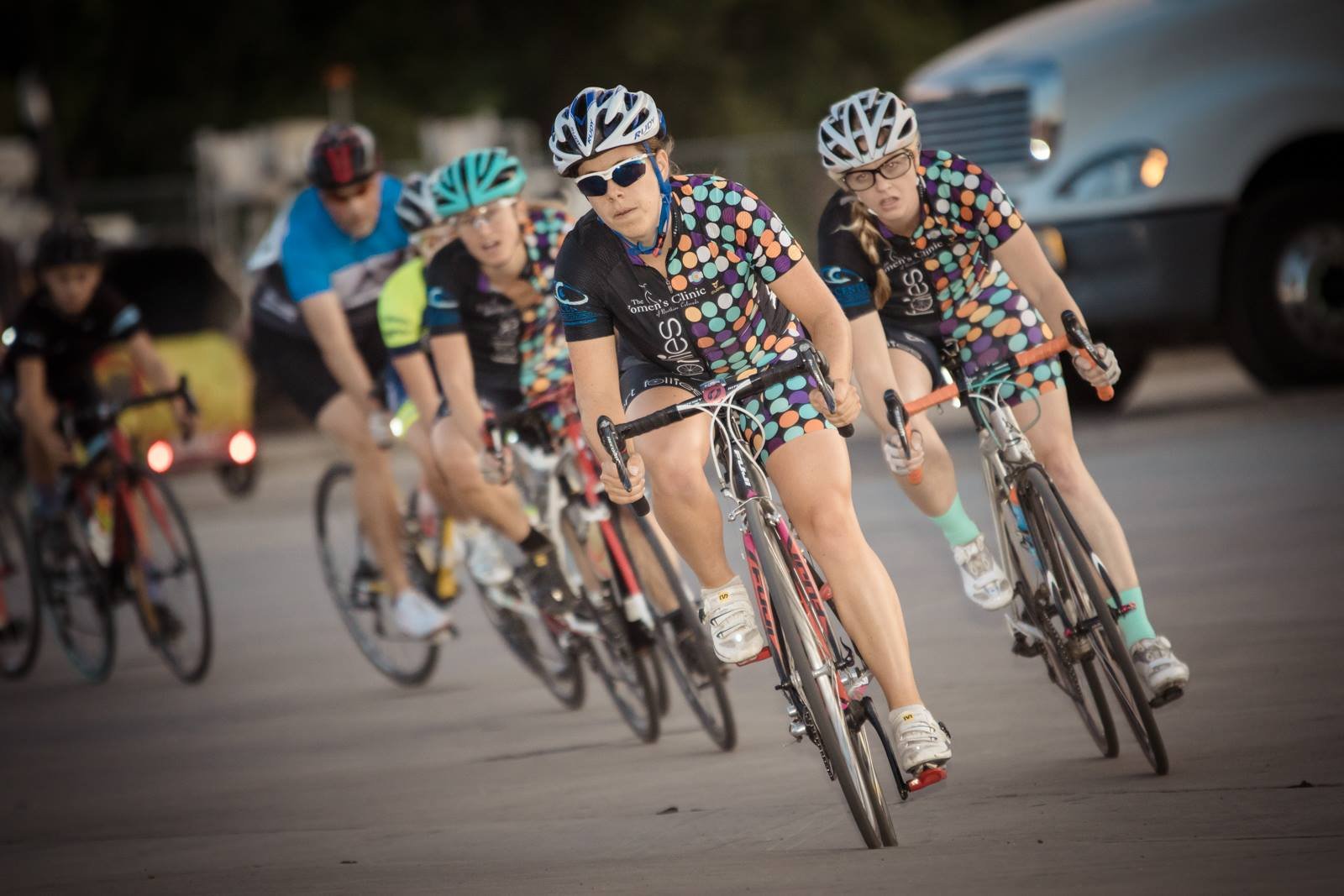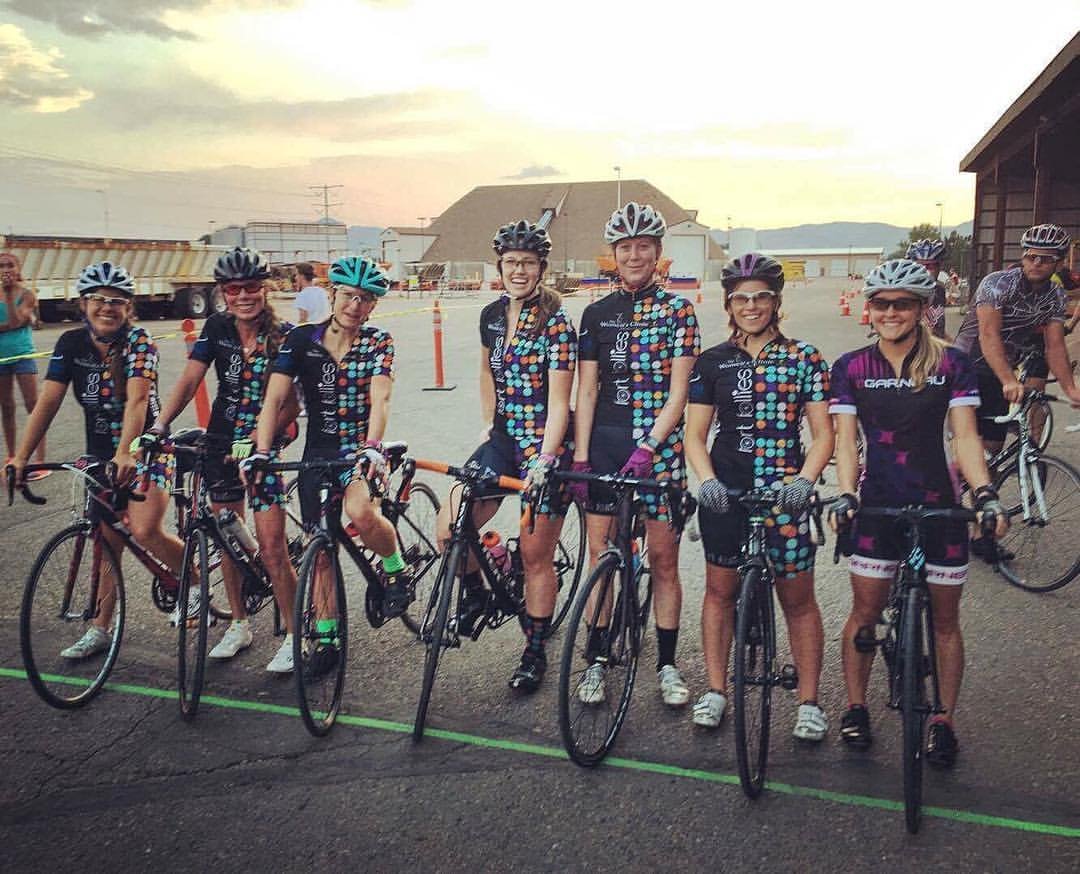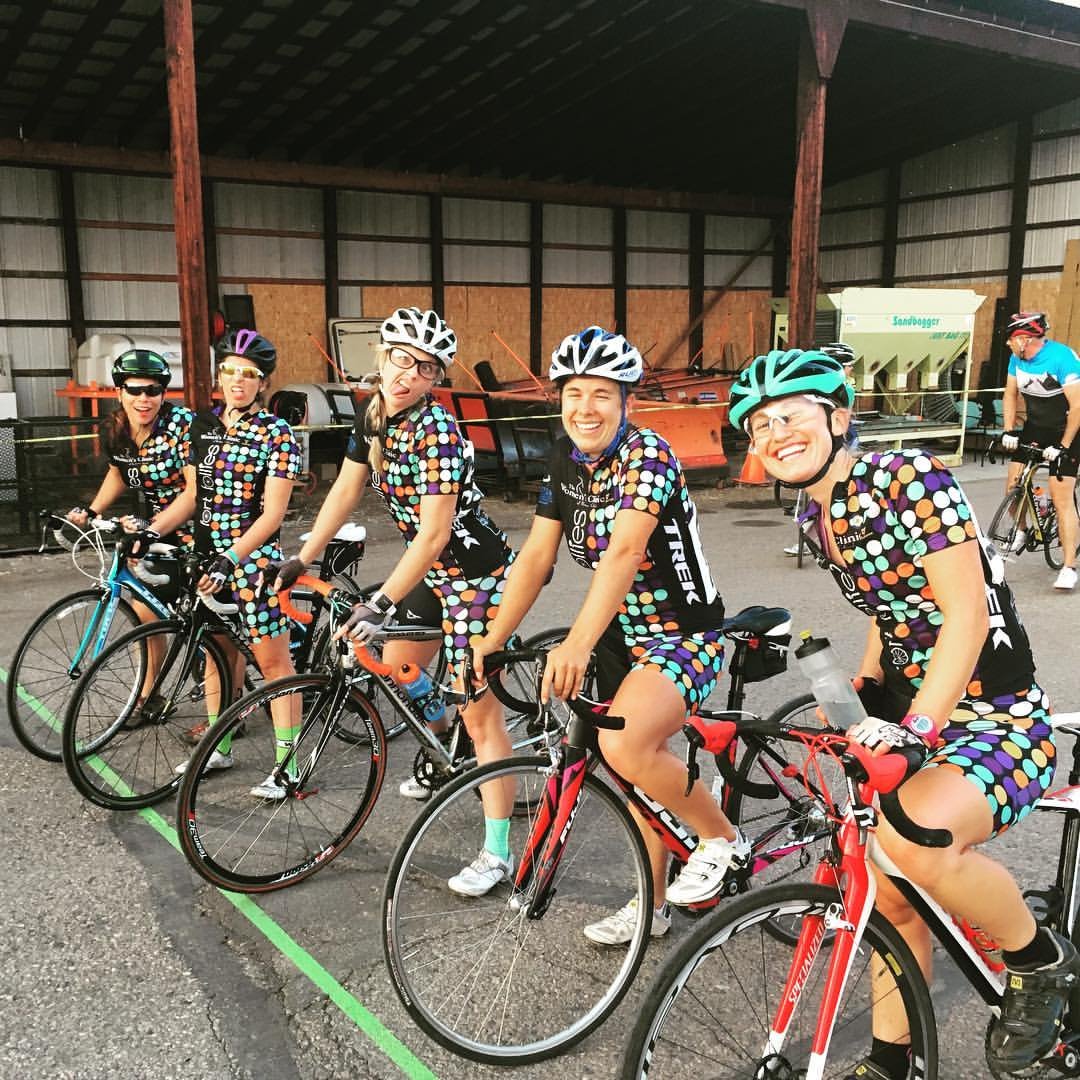Questions about your first Crit Race
Criteriums, also known as “Crits” are short and fast bicycle races that typically take place on city streets. They are closed to cars and feature a number of laps round a course features a number of turns. Crit races in particular have a reputation for being intimidating for new racers. To help make these races less intimidating, On August 8th, 2023 the Fort Follies are sponsoring a women’s night at the City Streets Criterium Series . As a part of this Fort Follies will be covering the registration fees for all women, femme, and non-binary riders who register, regardless of the category they choose to race. We will also be hosting a mini clinic lead by Sam Quijano before the races starts. Read more about this event on our events page. Before the event, We wanted to answer some of the common questions those who are new to Crits may have and share some tips from two Follies with previous Crit racing experience.
Sam Quijano (They/Them): .
Sam started racing in spring 2017 and races cat 2 on road. They have competed at Redlands Bicycle Classic, USA Pro Road Nationals, Cascade Classic, and Tulsa Tough.
(photo by: @tylerphillipsphoto)
Lilly Naimie (she/her):
Lilly races Cat4 and started riding to train for XC ski racing in college. She has competed in about 10 crits.
(photo by: @em.sierra)
What bike skills or experience should I have before a first Crit race?
Sam: If you know how to ride in a group at speeds of 18–20 miles an hour, you should be safe trying out a sanctioned crit. If you are unsure about either groups or speed, try out a practice crit to start building these skills!
Lilly: Being comfortable riding in a group is a great skill to have before riding in a Crit. If you aren’t sure, the back of the field generally has a little more space and is a good place to start the race. General comfort cornering at speed will also really help you.
How long should I be prepared to ride for?
Sam: Crits are not a specific distance. They are dependent on time. When you first start racing, a criterium may be advertised as short as 20 or 30 minutes. You will usually complete a couple laps and then the race organizers will provide an amount of laps to go based on the average time it is taking to complete laps for the main group of racers. Example: a 20 minute crit where the first two laps on average are about 2 minutes each will be given “8 laps to go” to complete the course in 20 minutes as planned. At the professional level, crits are usually 60-70 minutes long and sometimes even longer at events like Nationals.
Lilly: You should be prepared to ride for the advertised time of the race plus about 30 minutes to warm-up and 15-20 minutes to cool down. For the City Streets Crit, that would be a bit over an hour of riding. For distance, it really depends on the speed of the field.
What do the categories mean and which one should I register for?
Lilly: This will be my first time going to the City Streets Crits, so I can’t speak to the category speeds. But I would encourage all women to sign up with the women's race!! It is so much more fun when there are enough women to make a womens field.
Sam: The categories range from 5 up to 1, and then professional. When you’re starting out you will be racing in the “5” field, or more often the “Category 4/5" field. As you learn to race and earn points within the USAC upgrade system, you can upgrade your category. Moving through the categories becomes progressively more difficult.
For City Streets they use A, B, and C.
A: Pro, Cat 1, and Cat 2
B: Cat 2 , Cat 3, and Cat 4,
C : Cat 4, 5 and Collegiate.
They also have a categories for Women and Juniors/Kids.
Should my nutrition/hydration be any different than a normal road ride or race?
Lilly: Because these races are short, nutrition/hydration before the race can be significantly more important than during. Over 20 minutes, you really can’t take on nutrition that your body will process before the race is over. I have generally carried water or hydration mix (I prefer Skratch) and that's it. I like to eat a gel or pack of chews, really anything with high carbs/sugar, about 5 minutes before the start.
Sam: In a crit you are usually going too fast to take in nutrition other than hydration in a bottle. Sometimes, for long crits, folks will tuck a gel under their bib leg band to grab in the middle of the race since that’s usually all you can consume. Usually I wouldn’t bring more than one bottle with me unless it is very hot. I would put hydration in your bottle, however, just to give you that continuous stream of energy.
Are they dangerous? Why do you think are people are nervous to try them?
Sam: Obviously there is a risk in racing criteriums since you are riding at speed in a group of other people. It can be scary being in that environment if you are unfamiliar with it or if folks are acting in unpredictable ways. However, as with all things, it becomes a lot safer and more familiar with practice.
Lilly: I think folks are generally scared because there is an additional danger of falling when things start going fast and there are a lot of riders around you. As you get more comfortable riding close to others at high speed, it feels a lot safer! It can also be intimidating to start a race when you don’t know what to expect. I think that fear of something new keeps folks from jumping into races, that's part of why having a team (like the Follies!) who support you and help you belong can make such a difference. There is a huge confidence boost when you roll up to the race with your friends/teammates.
What do you need to know to ride safely during a Crit?
Sam: If I can impart any wisdom it is to protect your front wheel. You need to be aware of your space and especially your front wheel. Having that awareness will pay off in dividends in learning how to navigate a fast group and to be confident in yourself. Additionally, being predictable is the other big lesson for riding in a group. You do not want to move laterally unpredictably - especially through a corner.
Lilly: Jumping off of Sam’s advice to behave predictably, if it’s your first Crit your first instinct may be to slam on the brakes when you get nervous. If you need to brake, you really want to brake slowly and give the folks behind you enough time to respond. We all love that disc brakes can help you stop quickly, but unless you really need to stop, it’s important to not brake unpredictably.
What if I have an issue with my bike, should I still finish?
Sam: YES! If you have a mechanical or you’re involved in a crash, you can take what is called a “free lap.” There is an area on the course, usually by the start/finish line called “the pit” where there are usually mechanics and spare wheels, sometimes even spare bikes, for riders that have mishaps during the race. If you have a flat or another mechanical that isn’t your fault you can go to the pit and re-enter the race when the peloton comes around the lap again. However, you only have a lap to get to the pit so you need to go as quickly as possible to make sure you can re-enter the race in time. Also, mechanicals that are considered your responsibility (a loose seatpost, etc.) do not qualify you for a “free lap” and you will need to chase back onto the group if this happens. Free laps usually “end” or are no longer given at a set amount of laps remaining in the race (say, at 5 laps to go).
Lilly: Absolutely! My outlook is keep riding until they tell you to stop. Like Sam says above, hopefully you’ll be able to take care of the issue and get back in with the group. But if you can’t, oftentimes training races will let you keep going even if you’re off the back of the pack. Make sure you aren’t in anyone’s way and keep riding!!! There’s no shame in being off the back of the pack.
Is there any Crit specific lingo?
Sam: We’ve mentioned a few of these already, like “free lap” or “the pit.” There’s also “bell lap,” which is the final lap of the race. It’s called a ‘bell lap’ since usually a bell is rung to let the riders know the sprint is coming up and it’s the final lap of the race. A “break” refers to one to multiple riders getting some distance on the “peloton” (the main field). An “attack” or a “flier” is when a rider sprints in the middle of the race to try and get away from the peloton to establish a break. Riders will “chase” to try and bring the break back. Often in criteriums there are also “prime laps” (pronounced “preeme”) that act like mid race sprints. Usually a prize or money will be on offer for whatever rider crosses the line first at the start of the next lap when a prime is announced. You don’t necessarily need to do hand signals, but pointing out hazards or letting someone know you are in their blind spot, either through speaking or a light hand touch, is considered good manners.
Lilly: If someone says “Hold your line” that likely means that you started to (or significantly) moved to the side while cornering, this can be pretty dangerous because you can swing out into riders next to you and cause a crash. If it sounds harsh when someone says this, don’t take it personally!!! People can sound intense when they’re racing, but for the most part folks just want everyone to be safe. Make sure you ride your line through the corner next time and you’ll be fine! A couple of racing related phrases I really like are “on the rivet” which means that someone is really pushing hard, almost to their breaking point, and “yo-yoing off the back” which means that a rider is oscillating between being on the back of the group and having a gap between them and the group. Yo-yoing is usually indicative of someone having a hard time staying with the group, but don’t give up if it’s you!! You can always get a second wind and ride your way back solidly in the group.
What do you like about racing crits?
Sam: I love how dynamic and exciting racing a crit is. There are so many ways the race can play out, especially when the field is evenly matched. But really, my favorite part about crits is that it’s so fun to go fast! And it’s super spectator friendly.
Lilly: I love getting out there and pushing with a group of riders. The feeling of camaraderie in a women's field is pretty amazing too.
Any other tips you would share?
Sam: Don’t be afraid to ask questions and to try new things. You can only learn more if you don’t succeed in trying to go into a break, or sprinting for a prime - and you’ll never know if you might have succeeded if you don’t try!
Lilly: One of the best things I think I ever learned was how to spot and follow a good wheel. If you’re new to racing, be on the lookout for someone who looks extremely comfortable and solid on their bike. They’ll be relaxed in the pack, moving in a super predictable way, and moving straight (not swerving around in the peloton). Follow that person! Get on their wheel and see how they take the corners and navigate the race. For me, one of the best ways to learn is to watch and effectively copy someone who is clearly better than me.
We hope that this helped answer some questions you might have about trying a new type of race! The City Street Crits are designed to be a perfect first Crit race. Even if you don’t have a the most ideal bike or feel like you’re in race shape, we hope you come out and give them a try.
Still have questions? Find us on Instagram: @fortfollies





